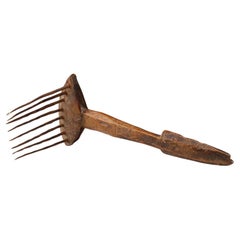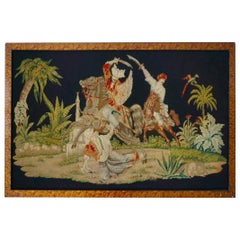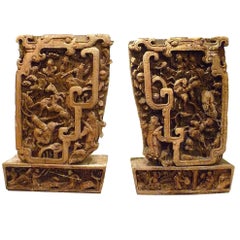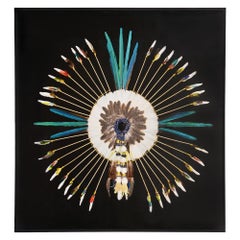French Tribal Art
to
4
1
3
2
1
2
2
3
2
2
2
1
156,637
766
630
368
194
5
5
5
1
Place of Origin: French
Contemporary Kayapo-Style Artwork Headdress With Moulting Feathers
Located in Paris, FR
Headdress in the style of Kayapo Amazonian Indian Tribal pieces, under frame made with moulting feathers sourced in France of blue Macaw feathers, and other South American bird feath...
Category
21st Century and Contemporary Tribal French Tribal Art
Materials
Feathers
French Bronze Sculpture "Crouching Native American Indian" E. Drouot
By Edouard Drouot
Located in Los Angeles, CA
A very fine French, 19th century Patinated bronze group of a Crouching Native American Indian on the lookout, in a dark brown patina and raised on a veined green marble base, by Edou...
Category
Late 19th Century Native American Antique French Tribal Art
Materials
Marble, Bronze
Contemporary Kayapo-Style Headdress With Moulting Feathers
Located in Paris, FR
Headdress in the style of Indian Tribe Kayapo under frame, made of moulting feathers from Blue Macaw, Blue-fronted Amazon, Rosablin, Triton and Alba cacaotès, Alexander parakeet, Demoiselle and Crowned crane, Chinese red rooster and Blue peacock; all sourced within France.
With Lapis lazulli...
Category
21st Century and Contemporary Tribal French Tribal Art
Materials
Glass, Wood, Feathers
Rare French 16th century primitive wool comb
Located in Meulebeke, BE
France / 16th century / wool comb / wood, metal / Rustic / Mid-century
A rare to find primitive wool comb from the 16th century.
Hand-crafted in France in wood with iron spikes.
This antique comb...
Category
16th Century Rustic Antique French Tribal Art
Materials
Metal
Pair of Gros – Point Stitched Panels Representing Orientalist Scenes
Located in Antwerp, BE
A pair of gros – point stitched panels representing orientalist scenes: One with a tiger hunt and the other with a battle scene, both in a setting of tropical vegetation on a black g...
Category
Mid-19th Century Tribal Antique French Tribal Art
Materials
Fabric, Wood
Related Items
Pair of Qing Dynasty Architecture Carving Panels
Located in Greenwich, CT
Pair of Qing dynasty architecture carving panels, detail carvings with warriors riding horses.
Category
19th Century Qing Antique French Tribal Art
Materials
Wood
Pair of Mughal Style Portait Panels
Located in San Marino, CA
Pair Hand-Painted Indian Portait Panels from the 20th Century.
Category
20th Century French Tribal Art
Materials
Wood
extremely rare Algerian Judaica silver, jewish Dowry box early 19th century
Located in Tel Aviv - Jaffa, IL
Amazing and scarce JUDAICA object, we have here one of the most touching jewish objects we had for a long time, this small silver dowry box was made in Algeria in the early 19th century, it is all covered with symbols of jewish faith and of couples, the sliding lid has 2 flanking birds with hamsa (protective hand) on each side and a flower vase in the middle.
one side shows two flanking lions with a tree in the middle and the other side shows again two big and two small birds with a flower bowl in the middle, front side has a key hole and next to it there is the Hebrew inscription ס״ט״" which says Siman tov or in English "a good sign" it is taken from the wedding blessing, underneath the lock there is another inscription with the name ״עזיזה בת אברהם בן חמו״ which is the name of the bride, her father and her grandfathers name.
the box is full marked a lot of times with the silversmith mark, every side of the box is marked.
this box was probably ordered by the grooms family to hold the jewelry they are giving to the bride as dowry, this type of objects are rare and there are just a few of them on museum collections.
DOWRY (Heb. נְדֻנְיָה), the property a wife brings to her husband at marriage; the Yiddish equivalent, nadn, is from the same root. The custom of nedunyah became clearly defined and institutionalized only in the talmudic period. In biblical times, mohar (מֹהַר), whereby the groom bought his wife from her father (Gen. 24:53; Ex. 22:15–16; Hos. 3:2), was the accepted practice. It was then customary that the groom give the bride gifts, and that she bring certain property to her husband's home upon marriage: slaves, cattle, real estate, etc. (cf. Gen. 24:59–61; 29; Judg. 1:14ff.; I Kings 9:16). Evidence of the custom of nedunyah is to be found in Tobit (7:14; 8:21) and in the Assuan papyri (Cowley, Aramaic, nos. 15, 18). Gradually, mohar was superseded by the ketubbah custom according to which the husband merely assumed the responsibility of compensation to his wife in case he divorced her: he had to pay her 200 zuzim if she had been a virgin at the time of marriage, and 100 zuzim if a widow or divorcée (see *Ketubbah).
By talmudic times, the institution of nedunyah was prevalent; the father gave a dowry to the bride since the daughter was excluded from paternal inheritance. Fifty zuzim (equivalent to the worth of 180 grams of silver) was the minimum amount a father was obliged to give to his daughter (Ket. 6:5). Parents usually gave much more, according to their social standing. Community funds provided the dowry for an orphan or a very poor girl (ibid.; cf. Sh. Ar., YD 251:8). In case of her father's death, the brothers of a minor girl were obliged to give her the minimum dowry, and the court estimated how much her father would have given her above the minimum dowry. The sum was then taken out of the father's estate and given to the daughter upon majority (Ket. 6:6; 68a–69b). In the absence of such an estimate, each daughter was entitled to receive one-tenth of the value of her father's estate in money, or in valuables (Yad, Ishut, 20:4–7; Sh. Ar., EH 113:4). If the father was unable or unwilling to pay the promised dowry at the betrothal ceremony, the groom could refuse to marry his bride (Ket. 13:5; Ket. 108b–109a). Insistence on exact payment of the promised dowry, however, was frowned upon by later rabbinic authorities (Rema to Sh. Ar., EH 2:1). In certain communities it was customary for the groom's father to make a dowry contribution equal to that of the bride's father (Ket. 102b). The dowry, whether given in real estate, slaves, money, or chattel was recorded in the marriage contract (the ketubbah) and in some instances one-third or one-fifth of the actual value of the dowry was added to the sum mentioned in the ketubbah. Based upon a decree enacted by *Simeon b. Shetah (first century C.E.), the Talmud ruled that the husband and his entire property were liable for compensation as stipulated in the ketubbah, either in case he died (when she collected the sum specified in the ketubbah from the heirs) or in case he divorced his wife (Ket. 82b). For the status of the dowry and the husband's rights and obligations, see below. The rabbinic enactments (Takkanot Shum) by R. Jacob *Tam and by the rabbinic synod of the communities of Speyer, Worms, and Mainz (Germany) stipulated that if a woman died...
Category
Mid-19th Century Antique French Tribal Art
Materials
Silver
$15,000
H 2.8 in W 2.8 in D 5.6 in
Bronze Satyr Sculpture on Marble Base by Edouard Drouot (1859-1949)
By Edouard Drouot
Located in Palm Desert, CA
This striking bronze sculpture by acclaimed French artist Edouard Drouot (1859–1945) depicts a spirited satyr figure in motion, playing a pair of pipes with exuberant energy. Cast in...
Category
Early 20th Century Belle Époque French Tribal Art
Materials
Marble, Bronze
Mid-20th Century Cast Stone Architectural Panels, a Pair
Located in Morristown, NJ
20th C., cast stone panels with attractive patina. The panels could be used outdoors or for interior decoration. The back side of the panels have metal wall mounts.
Dimensions:
6...
Category
Mid-20th Century Chinoiserie French Tribal Art
Materials
Cast Stone, Metal
Large Antique Indonesian Kris Dagger – Ethnographic collectible weapons
Located in London, GB
Large Antique Indonesian Kris Dagger – Ethnographic collectible weapons
A striking and authentic large antique Indonesian Kris (keris) dagger, dating to the early 20th century. This traditional Southeast Asian weapon features a dramatic curved zigzag (luk) blade, expertly forged and finely detailed, symbolizing power and spiritual energy. The blade is paired with a carved Horn hilt and shaped wooden sheath, showcasing classic Indonesian...
Category
Early 20th Century French Tribal Art
Materials
Wood
$531
H 18.9 in W 5.91 in D 1.19 in
Mid-20th Century Ceremonial Comb, Luba People, Zaire, D. R. Congo
Located in Point Richmond, CA
Ceremonial comb, Luba People, Zaire, D. R. Congo
Made of palm leaf midribs, this large, graphic comb has a pinched waist and is held together with finely wrapped wire. Presented o...
Category
Mid-20th Century Tribal French Tribal Art
Materials
Wire
Rare Silver Balangandãs - 20th Century Brazilian Native Hanging Amulet
Located in Rio De Janeiro, BR
Mid 20th century brazilian silver hanging amulet from native culture in Brazil. Known as "Penca de Balangandãs" was used in the ancient times as an amul...
Category
Mid-20th Century Other French Tribal Art
Materials
Sterling Silver
Yoruba Nigeria African Royal Beaded Headdress Crown on Lucite Stand
Located in North Hollywood, CA
West African hand beaded head dress crown from Yoruba, Nigeria.
This artistic beautiful and functional art piece is covered with beads in turquoise, orange, green, yellow red, blue ...
Category
Mid-20th Century Tribal French Tribal Art
Materials
Metal
Lapis Lazuli Native American Indian Chief Statue
Located in Somis, CA
We discovered, and through extraordinary efforts acquired this rare lapis lazuli Indian chief statue, capturing the essence of a Native American leader ad...
Category
20th Century Native American French Tribal Art
Materials
Lapis Lazuli
Yoruba Nigeria African Red Royal Beaded Headdress Crown on Lucite Stand
Located in North Hollywood, CA
West African hand beaded head dress crown from Yoruba, Nigeria.
This artistic beautiful and functional art piece is covered with beads in ivory, red and black colors with faces bird...
Category
Mid-20th Century Tribal French Tribal Art
Materials
Metal
$1,850
H 46 in W 10 in D 10 in
Important Dan N'gere Mask, Pace Primitive Provenance
By Dan People
Located in Sharon, CT
Superb mask with typically strong features and kaolin around the eyes. Advertised by Pace Primitive in Arts D'Afrique Noire 74. Ex. collection Al Ross (1911-20...
Category
Late 19th Century Primitive Antique French Tribal Art
Materials
Wood
Previously Available Items
Indian Tribe Kayapo Headdress
Located in Paris, FR
Headdress Indian Tribe Kayapo under frame made of Blue Macaw,
Blue-fronted Amazon, Rosablin, Triton and Alba cacaotès, Alexander
parakeet, Demoiselle and Crowned crane, Chinese r...
Category
21st Century and Contemporary French Tribal Art
Materials
Glass, Wood, Feathers
Indian Tribe Headdress under Frame
Located in Paris, FR
Indian Tribe Headdress under Frame made with blue Macaw feathers, green
parrot feather and other south american bird feathers. Delivered with cites.
...
Category
21st Century and Contemporary French Tribal Art
Materials
Wood, Feathers
Africanist Palmwood Pedestal by Charles Combes
By Charles Combes
Located in New York, NY
Charles Alphonse Combes (1891-1968)
An exceptional carved stele in solid palmwood, in the Africanist style of the 1931 Paris Exposition Coloniale...
Category
1950s Primitive Vintage French Tribal Art
Materials
Palmwood






